Anticipatory designing and shared survivable futures
Andrew Morrison looks at links between design and anticipatory inquiry in the context of changing environmental, professional, educational and geo-political conditions.
By Professor Andrew Morrison, Oslo School of Architecture and Design (AHO)
Anticipatory Design: Beyond the horizons of foresight
As an emerging domain, Anticipation Studies (Poli & Valerio, 2019) encompass systems, governance and policy perspectives situated in notions and practices of foresight and futures. However, it also includes cultural studies and design practices and creative sector inquiry, such as articulated at the 3rd International Conference on Anticipation hosted by AHO in Oslo in 2019[1] and reflected in selected articles in recent issues of the Futures journal.
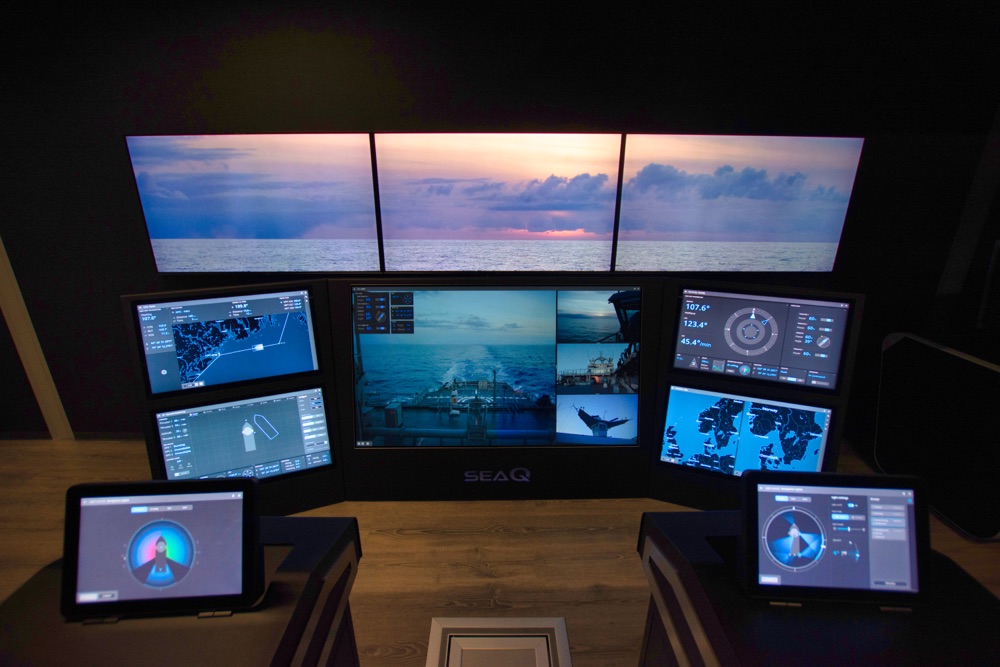
Anticipatory Design [2] works to shape and to interpret transactional, imaginary and exploratory inquiry and engagement, ranging from the built to the sensory. Drawing on diverse disciplinary practices and modes of inquiry in design research and practice, Anticipatory Design offers a counterweight to the strategic decision making of more traditional foresight.
It does so to expand intersections of materials, tools and methods of making and shaping futures contextually and systemically.
To date few connections have been made between anticipation, design located innovation and policy framing, generation and actualisation. On offer is a range of research through design projects, linked courses and modes of communicating anticipation.
Central is the notion that innovation and policy fields may benefit from richer, contextually located knowing through making, by designing and with situated analyses and disseminating dialogues.
Staying afloat: Anticipation through making open design
The Ocean Industry Concept Lab (OICL) [3] at AHO is a research and development project based venue that explores emerging technologies and field knowledge to redefine marine workplaces. Dynamic, contextual and collaborative acts of making new knowledge with near future applications, are realised through the merging of digital tools, competencies, processes and multimodal communication.
Key to design-based innovation is the ability to connect design ideation and real world needs and motivations. These must be combined real-time data linked with on-site visits.
The lab is based on principles and practices and outcomes found in open innovation.[4] It provides an online collaborative platform for disseminating and supporting innovation in the wider sector, and is also propelled by a large fleet of leading national and international partners from research and industry sectors. [5]
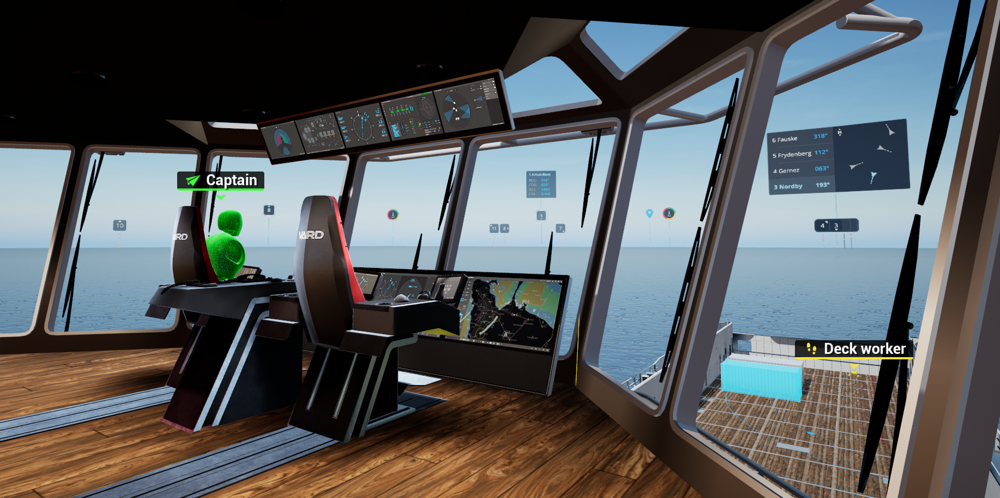
Anticipatory designing is a mode of close-knit collaboration, including industry partners inputs, and is in effect a mode of inquiry in its own right. It spans concepts development through sketching and modelling, and this extends to full scale interactive demonstrators connected to AHO’s workshop facilities and available as resources in the lab space that further support reflection in action.
Such work is possible due to the systemic development of an open software and work platform that facilitates rapid development, sharing and device connections and interfaces.
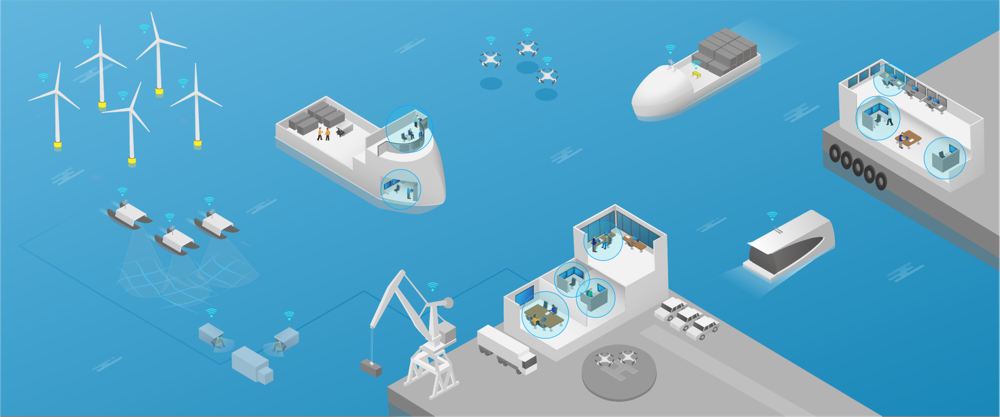
Anticipatory designing is active, iterative and emergent yet it is situated in the world of work and relations of new tools for designing in AR/VR, not only for large ships, interfaces and work spaces and actions, but for design work processes.
The neighbourhood of the future: Anticipatory Design and Digital Urban Living
Intersections between interaction designs and urbanism have been elaborately developed and communicated in The Oslo Futures Catalogue. [6] This is a collaborative work between master’s design students and three core designer-researcher educators at AHO, Einar Sneve Martinussen, Dan Hill and Aleksandra Zamarajeva Fischer.
It was developed in the autumn of 2021 as a complement to a partnership with the Municipality of Oslo, the design companies Ramböll and Halogen and the D-Box national centre for transforming public services.
D-box [7] pursues the potential of innovation in the public sector with design as a lead driver. AHO is a partner to the emerging collaboration of this key site for transdisciplinary innovation through a focus on education, connection, communication and research. Co-creation across sectors and expertise is central, as is connecting knowledge institutions, diverse practice, and citizens.
Connected to the Digital Urban Living (DUL) [8] project at AHO, this Catalogue similarly takes up relations between digital design and social development and change. With a focus on neighbourhoods, also key to the 2022 Oslo Architectural Triennale (OAT), [9] the course was located in strategic design and strategy processes and is extensively documented by Guest Prof. II Dan Hill. [10]
He explains that ‘Rather than selecting one idea to dig into, the direction was to produce a diverse array of observations and propositions, a rich catalogue of possibility which others might draw from, build with, expand, adopt and adapt to their own needs. These are seeds to be combined in more resilient companion planting, rather a monoculture.’
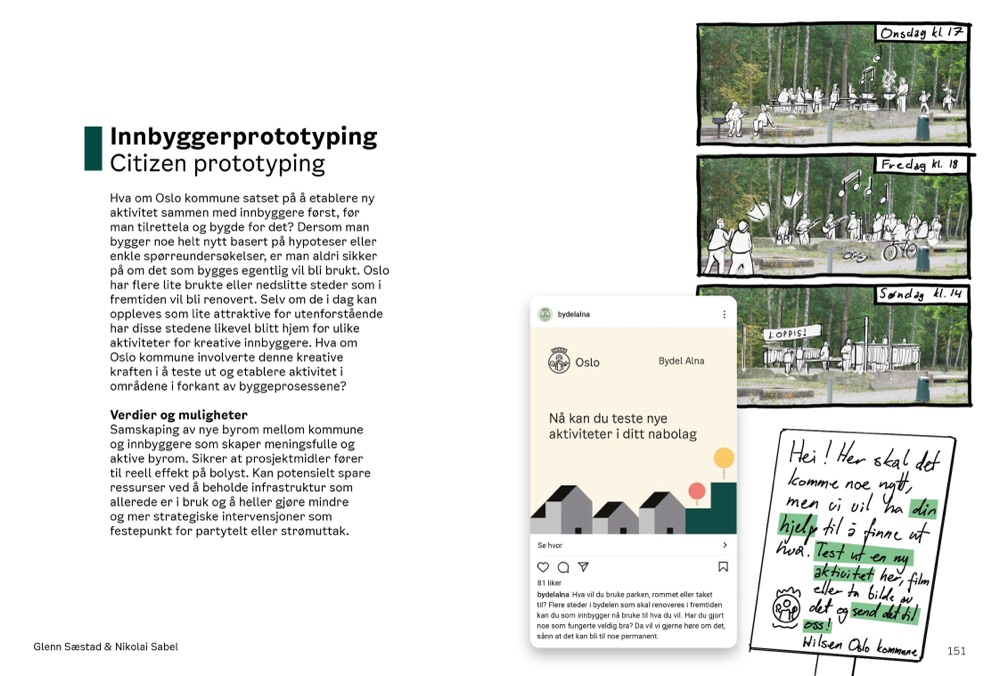
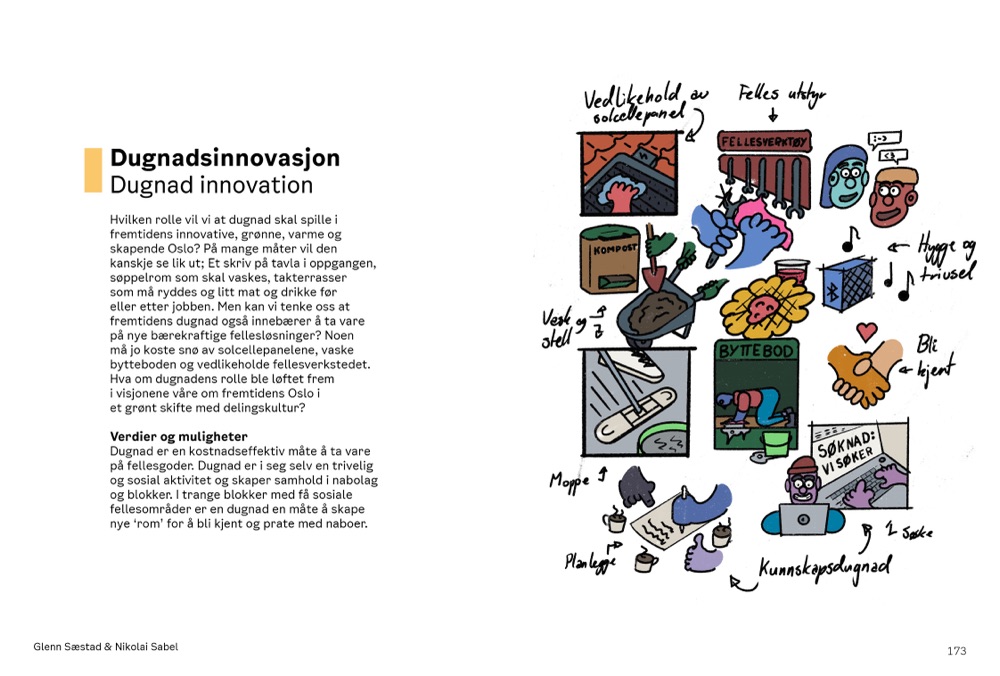
At the heart of the anticipatory design ethos of the course is a shift from ‘What is?’ observations on everyday life of current Oslo neighbourhoods (disused buildings, patterns of ownership, belonging and cultural production, food and biodiversity) to a set of emerging ‘What if?’ propositions or glimpses.
Feeling the future: Experiential service design for public sector innovation
In the past decade, and increasingly in Norway, relations between service design, the public sector and modes of innovation and policy formation have undergone considerable change. Broadly, there has been a shift from design for policy to design in policy. [11]
Ted Matthews, Assoc. Prof. in Service Design at AHO, has asked ‘How can we understand policy and public service design and services as less matters of top-down decision making and more ones of offering visceral experiences of being engaged in shaping futures by design?
One response has been charting a new four-week master’s service design course with Adrian Paulsen from the design company Halogen.
An outcome was the generation of exhibition and discursive spaces for engaging participants, government officials, policy makers and citizens in sensory and experiential access to potential near future realities. Four installation pieces were designed to provide anticipatory engagement in diverse lived experiences.
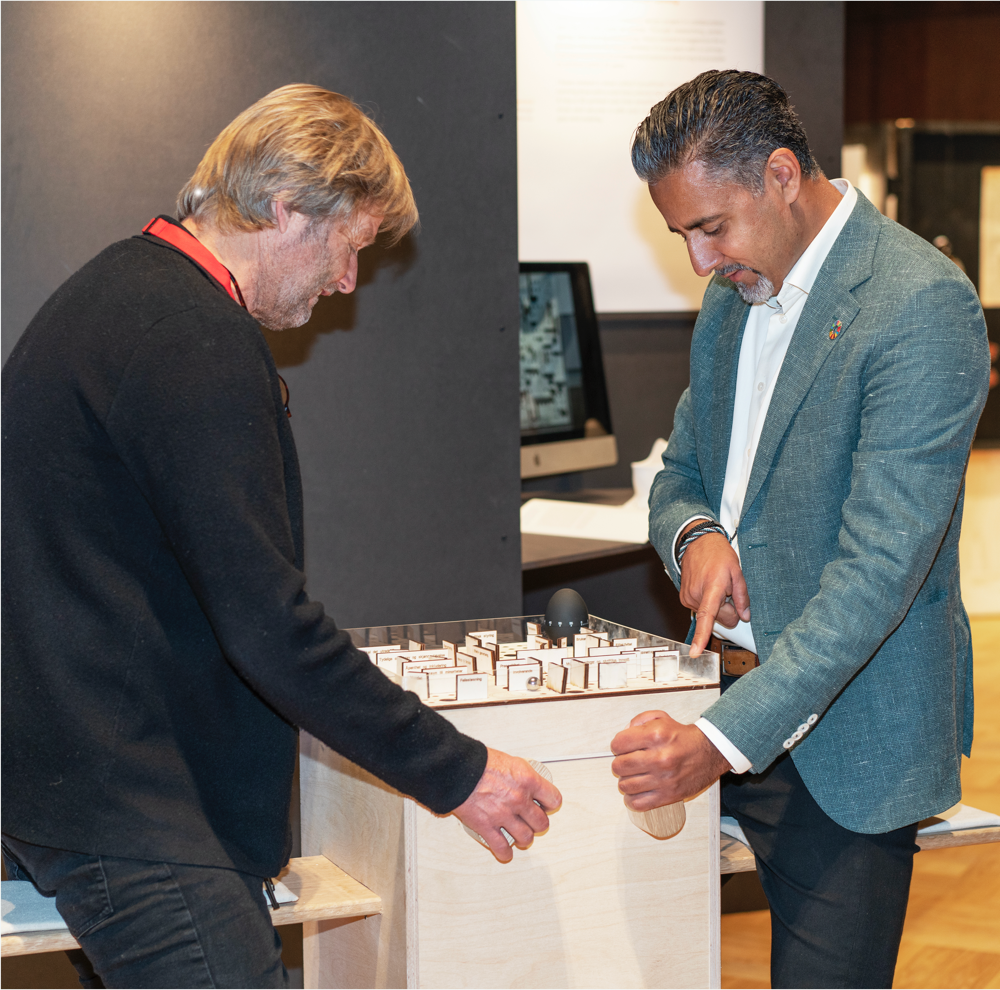
The aim has been to transpose the abstract and projected aspects of public services into tangible stories about the near future as they may be experienced. These may help a diversity of actors in conceptualizing and realising public policy and services.
This was visible when participants to the exhibition, one a governmental minster and one a design educator, collaborated in a form of policy agreement to move a ball through a symbolic bureaucratic maze of holes and moveable walls labelled with statements or rules, policies and laws.
Shaping care-ful futures by design: Constructing critiques in public health
Also an AHO contributor to D-box, Assoc. Prof. Josina Vink has been engaged in drawing together her diverse design and research expertise in service design education and research in AHO’s partnership on the research-based innovation Centre for Connected Care (C3). [12]
They have been looking at how to extend home based care, calling into question some of the dominant approaches in health care and policy. Person centred perspectives need to consider relations to need, home and the wider city spaces. This has entailed study of the in-betweenness of service design practitioners as intermediaries in service-system aspects of healthcare (Romm & Vink 2019).
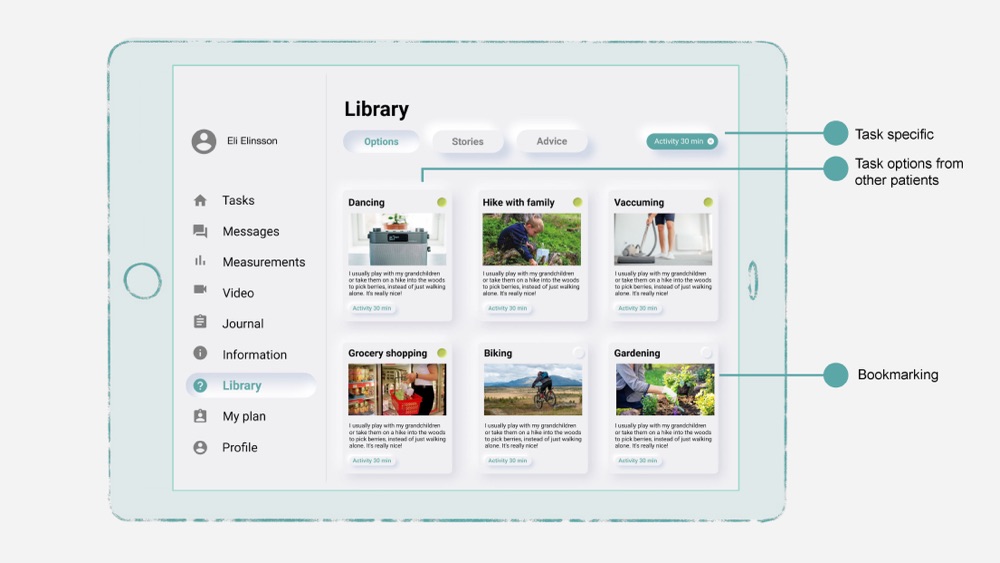
Further, students have been engaged in designing services that avoid the existing work of family careers being disregarded while seeking to generate connected ‘careful’ experiences. This has been realised by design artifacts and modes of engagement that offer service designers prompts for reflecting on cultural diversity within and across home based care settings.
Re-futuring: A world of conviviality, autonomy and cooperation
In the context of designing for and within long terms sustainability in an age of climate change and planetary denudation, one research group at AHO has worked to elaborate the concept and practice of ‘re-futuring’. [13]
Jomy Joseph writes that the group has attempted a ‘different navigation’ to rehumanize and reclaim the dehumanized present such that the future is profoundly different when we arrive in it. We need to go beyond climate despair and instead try to envision a long-term sustainable future.’
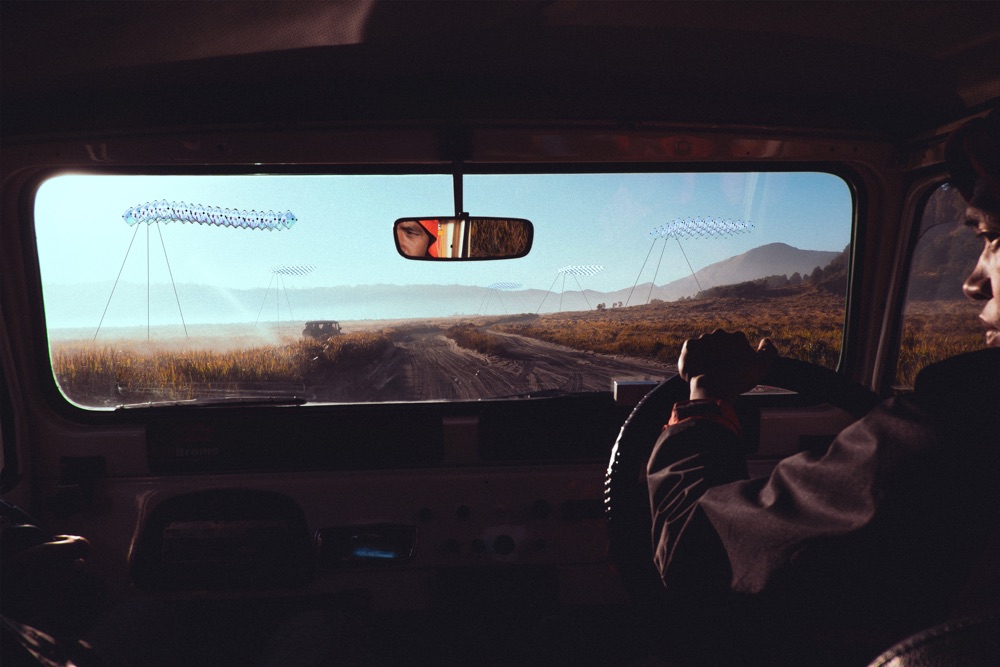
The work of this studio has recently flourished in the form of a design fictive open access publication The Open Journal of Refuturing that makes extensive use of visual futures scenarios and related design fictive yet critical discourse.
Joseph ventures that ‘… in telling a compelling narrative of radically different futures, an encounter with a conflicting artefact may lead to a creative speculation of its own.’
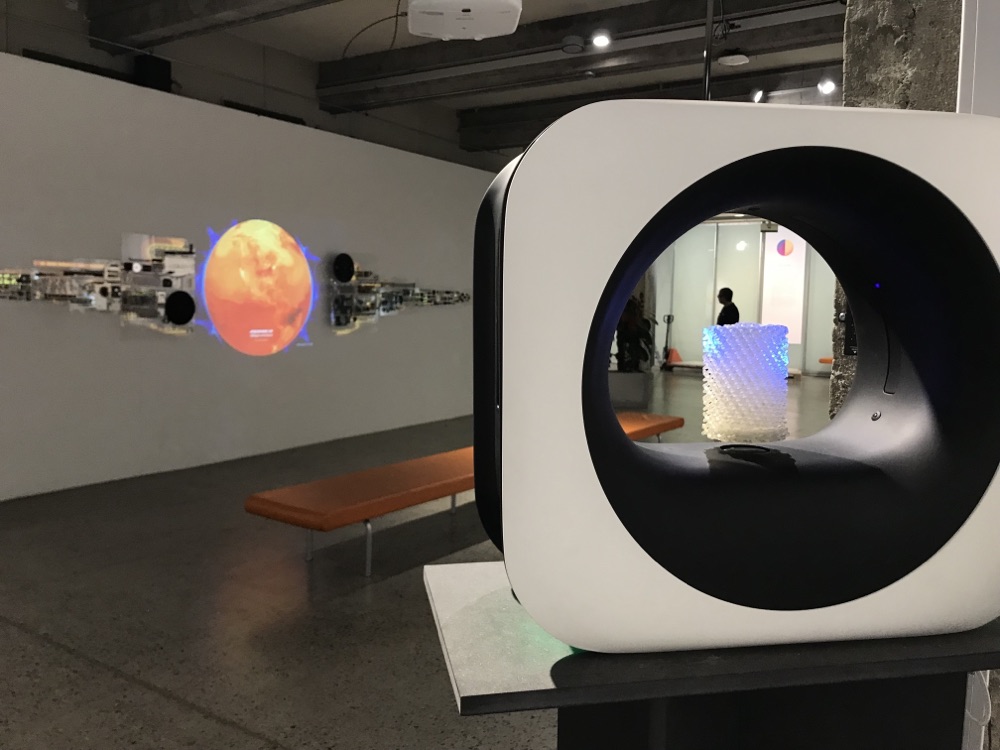
This speculative work has been partnered with online seminars entitled ReFuturing Studies: Investigating Ecologies of Climate Action [14] with international speakers, research studio and AHO presenters and participants.
The events were located within an exhibition space, curating a range of related themes and Artifacts from the Pluriverse [15] in which ‘the urgency of climate action requires of us to explore the kind of choices that may lie ahead, beyond the limiting binaries of climate denialism and climate fatalism’.
Anticipatory Design in post normal times: From speculative designing to urgent critical presents
Writing about Anticipatory Design seems trivial yet profound when the complexities of our postnormal times – climate change, global pandemic and war – co-occur.
In these settings, thinking with the imaginary, shaping design for better tomorrows is core to a radical recasting and refuturing of design. [16] In a framing given by Hanna Arendt, anticipatory design needs courage of imagination, of creative expression and of critical appraisal, perhaps so that together it may be appreciated as a mode of facilitating ‘anticipatory thinking through landscapes’. [17]
The Amphibious Trilogies [18] project also reached into imaginary design futures via an narrative online device. It has worked performatively through the futures persona of an octopus, called OCTOPA (www.octopa.org). OCTOPA is an online device through which to symbolically and affectively problematise the scales of anticipatory knowing and relational co-design.
This work has been connected to the FUEL4DESIGN [19] project into design futures literacies that adds design into future literacy as propagated through Riel Miller and UNESCO. Anticipatory design is seen as a central frame for the realisation of productive and critical design futures literacies.[20]
OCTOPA takes us into an online environment of pastiche, legacies, irony, allegory and unexpected twirls of fact and fiction. With the Northern Sea Route as her domain, we are invited to engage in a distributed interplay of making sense of seemingly scrambled futures to bring us back to different, and perhaps alternate, presents. Her polyverse is one of serious play; hers is a vast region with diverse features and interests, unavoidably saturated with geo strategic and energy power plays.
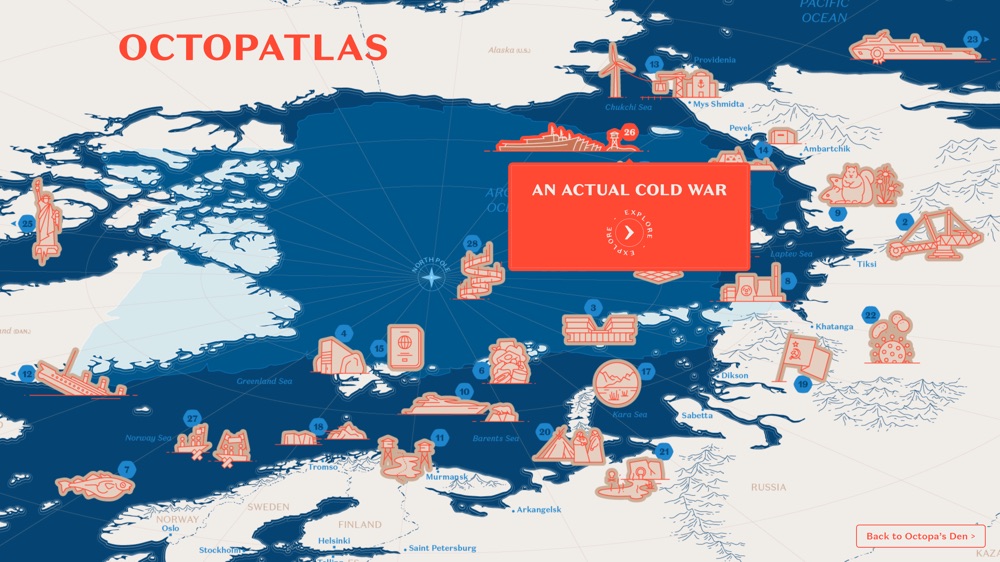
Anticipatory Design projects, emergent practices and their transdisciplinary analyses offer us some means to shift thinking and action for shaping durable and more equitable worlds and connect the worlds of innovative work, daily life, pedagogy and public policy.
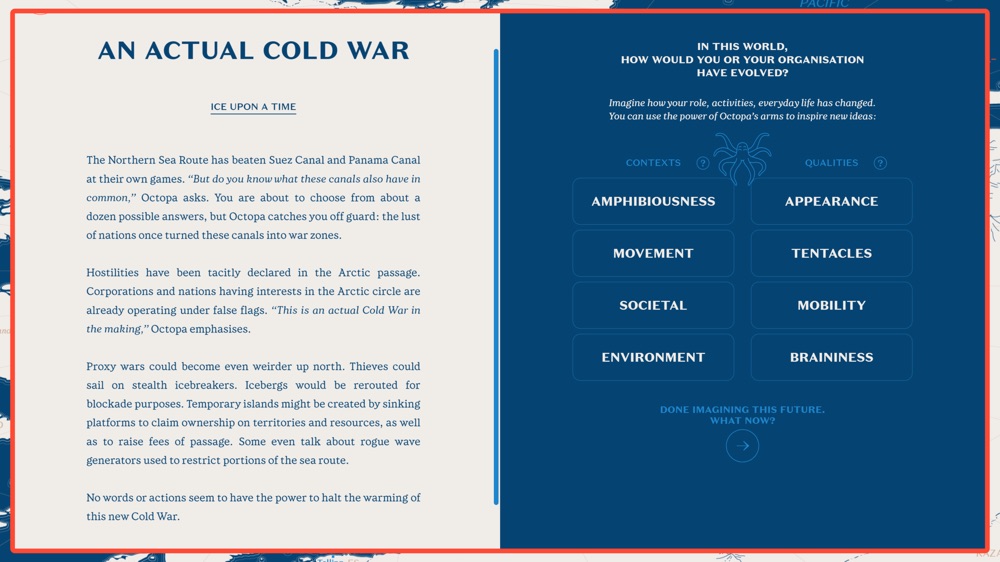
This article has been written in consultation with AHO designer-researchers: Kjetil Nordby, Einar Sneve Martinussen, Ted Matthews, Josina Vink, Jomy Joseph, Håkan Edeholt and Corbin Raymond.
Illustrations from AHO.
References
AHRC Design Fellows (2020). Challenges of the Future. Public Policy. Arts and Humanities Research Council: UKRI/ Cardiff. Cardif Metropolitan University
Bali, A,. Capano, G.& Ramesh, M. (2019). Anticipating and designing for policy effectiveness
Policy and Society, 38(1): 1-13. Available: https://doi.org/10.1080/14494035.2019.1579502
Celi, M. & Morrison, A. (2017). ‘Anticipation and design inquiry’. In Poli, R. (Ed.). Handbook of Anticipation. Vienna: Springer, 1-25 (online).
Edeholt, H., Joseph, J. & Xia, N. (2021). ‘Walk the talk: Toward an ecological futures framework for our designed cultures’. In Proceedings of DESIGN CULTURUE(S) CUMULUS ROMA 2021. 3863-3877. Available: https://cumulusroma2020.org/proceedings/
Howlett, M. Capano, G. & Ramesh, M. (2018). ‘Designing for robustness: surprise, agility and improvisation in policy design’. Policy and Society, 37(4): 405-421. Available: https://doi.org/10.1080/14494035.2018.1504488
Johnson, J. & Cook, M. (2013). ‘Policy Design: a new area of design research and practice’. In Aguier, M., Boulanger, F., Marchal, C. & Krob, D. (Eds.). Complex Systems Design & Management. Berlin: Springer.
Joseph, J. (2019). ‘Critical futures today: Back-casting speculative product design towards long term sustainability’. In Ambrosio, M. & Vezzoli, C. (Eds.). Designing Sustainability for All. Proceedings of the 3Rd LeNS World Distributed Conference, Vol. 3, 904-909. http://www.lensconference3.org/images/program/VOLUME3.pdf
Joseph, J. (2021a). The Open Journal of Refuturing. Centenary Special Issue, Spring 2131. Oslo: Open Design Society.
Joseph, J. (2021b, forthcoming). ‘ReFuturing Studio: Designing long-term sustainability for the biosphere’. ACSA/EAAE Teachers Conference: Curriculum for Climate Agency: Design (in)Action 2021.
Miller, Riel. (2018). (Ed.). Transforming the future. Anticipation in the 21st century. Paris: UNESCO/Abingdon: Routledge.
Morrison, A., Nordby, K., Arnall, T. & Westvang, E. (2015). ‘Breathing life into research mediation’. In Carlin, D. & Vaughan, L. (Eds). Performing Digital: multiple perspectives on a living archive. London: Ashgate. 161-184.
Morrison, A. (2019). ‘Anticipatory thinking through landscapes’. In Kampevold Larsen, J., Hemmersam, P. & Morrison, A. 2019. (Eds.). Future North Kola. Oslo: Institute for Urbanism and Landscape, Oslo School of Architecture and Design (AHO). 54-89.
Morrison, A. (2021). ‘Courage’. In Staszowski, E. & Tasanari, V. (Eds.). Designing in Dark Times. An Arendtian Lexicon. London. Bloomsbury. 95-98.
Morrison, A., Celi, M., Clèries, L. & Dudani, P. (2021). ‘Anticipatory design and futures literacies’. CUMULUS ROMA 2021.
Morrison A. & Cleriès, L. (2020). (Eds.) ‘Design Futures Now: Literacies & Making’. Special Issue Temes de Disseny. # 36. Available: https://www.raco.cat/index.php/Temes/issue/view/28324
Morrison, A, Kerspern, B., Dudani, P. & Steggell, A. (2021). ‘Amphibious scales and anticipatory design’. In Proceedings of NORDES 2021: Matters of Scale. Available: www.nordes.org
Nordby, K., Gernez, E., Fredenberg, S. & Eikenes, J.O. (2020). ‘Augmenting OpenBridge: An open user interface architecture for augmented reality applications on ship bridges’. 19th Conference on Computer and IT Applications in the Maritime Industries – COMPIT.
Nordman, A, (2014). ‘Responsible innovation, the art and craft of anticipation’. Journal of Responsible Innovation, 1(1): 87-98. DOI: 10.1080/23299460.2014.882064
Poli, R. & Valerio, M. (2019). Anticipation, Agency and Complexity. Cham: Springer.
Romm, J. & Vink, J. (2019). ’Investigating the “in-betweeness“ of service design practitioners in healthcare‘. In Pfannstiel M. & Rasche, C. (Eds.). Service Design and Service Thinking in Healthcare and Hospital Management. Cham: Springer International Publishing. 117-135.
[1] https://web.archive.org/web/20210812153426/
http://anticipationconference.org//
[2] Celi & Morrison, 2017; Morrison et al. 2021
[3] Ocean Industries Concept Lab:
[4] In open innovation learning through collaboration with other actors is more important than secrecy and ownership of ideas.
[5] Presenting Ocean Industries Design System (Prof Kjetil Nordby)
[6](PDF)
[7] D-Box: https://www.d-boxnorway.com/
[8] https://medium.com/digital-urban-living
[9] Mission Neighbourhood’.
[11] AHRC Design Fellows, 2020
[12] https://c3connectedcare.org/
[13] Edeholt & Joseph, 2022
[16] Joseph, 2021b
[17] Morrison 2021 and 2019
[18] http://amphibious.khio.no/
[19] http://www.fuel4design.org/
[20] Miller 2018; Morrison & Cleris, 2020; Morrison, 2021
